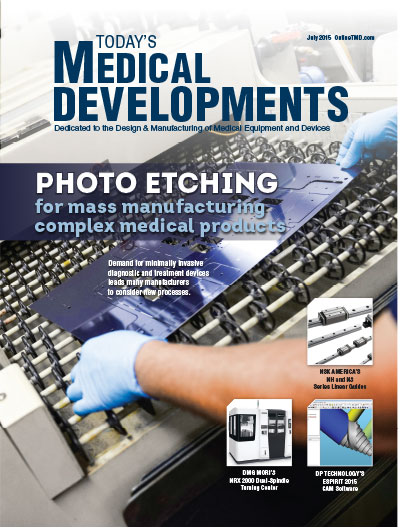 Surgical staples, first developed in 1908 by Dr. Hümer Hültl, have undergone multiple design and manufacturing iterations. Ethicon Inc. has been manufacturing surgical sutures since 1969, and its new powered vascular stapler (PVS) is improving user-controlled precision. The PVS provides a very narrow, curved blunt anvil and a thinner shaft for 11% greater manual articulation in each direction than competing products, and more flexibility during final placement.
Surgical staples, first developed in 1908 by Dr. Hümer Hültl, have undergone multiple design and manufacturing iterations. Ethicon Inc. has been manufacturing surgical sutures since 1969, and its new powered vascular stapler (PVS) is improving user-controlled precision. The PVS provides a very narrow, curved blunt anvil and a thinner shaft for 11% greater manual articulation in each direction than competing products, and more flexibility during final placement.
“PVS was defined by an iterative, interactive process of discovery that utilized the input of hundreds of thoracic surgeons around the globe,” says John Hunt, principal industrial designer at Ethicon. “We started with illustrations and descriptions of possible options that were evaluated by users and used as the building blocks for physical models and prototypes that were further modified and perfected.”
Ethicon designers use ALIAS Design, SolidWorks, NX, and Adobe CS software to develop medical devices.
Ethicon engineers designed the PVS to handle the specific characteristics of tissue being manipulated and transected, with contributions from outside engineers, designers, and surgeons.
“Understanding the tissue properties allowed us to pursue a secure, hemostatic vessel transection via the smallest possible end effector to minimize dissection,” Hunt says. “A thorough review of anatomy and surgeon techniques also enabled us to provide more precise placement through increased degrees of articulation and a shaft designed for optimal length and minimal diameter to allow for less intercostal pressure.”
 Ethicon engineers designed the articulation mechanism for high-quality feel and feedback, which included audible feedback to signal changes in tissue thickness.
Ethicon engineers designed the articulation mechanism for high-quality feel and feedback, which included audible feedback to signal changes in tissue thickness.
Another PVS innovation is a powered handle, designed for stable application of force – substituting push-button ease-of-use for previous devices that required multiple manual squeezes
“Design objectives were, through miniaturization, to allow for less dissection around critical structures, less pressure on nerve bundles during placement, and easier access to the targeted anatomy,” Hunt says. “This, coupled with a secure, powered firing, provided a higher level of precision throughout the vascular transection job of the procedure.”
The stapler’s end effectors are machined from solid, surgical steel billets, and the handle housing is molded from the same polymer used to make bullet-resistant glass. Other material choices for the PVS are based on strength and ability to withstand intense radiation sterilization.

“One of the reasons surgeons and hospitals choose our products is for their sterility,” Hunt explains. “Most of our devices are assembled in cleanroom conditions and then radiation-sterilized in-house after they are sealed in their specific packaging.
“Compliant plastic over-molding is provided for maximum tactile grip and feedback from the handle and rotation controls,” Hunt adds. “Batteries are chosen for their reliability and ability to be radiation sterilized. Plus, they have a discharging circuit that reduces them to inert salts after use, simplifying often-complicated medical-waste disposal scenarios.”
 At Ethicon, nearly all parts, components, sub-systems, and products are first physically modeled with 3D printing. By the mid-1990s engineers had early stereolithography technology in-house, and the Industrial Design Human Factors team at Ethicon has been utilizing 3D printing internally since 2002.
At Ethicon, nearly all parts, components, sub-systems, and products are first physically modeled with 3D printing. By the mid-1990s engineers had early stereolithography technology in-house, and the Industrial Design Human Factors team at Ethicon has been utilizing 3D printing internally since 2002.
“When developing new products we follow a process of designed-to-value (DTV) that follows the triple-aim objectives of the Affordable Care Act (ACA). This process helps us ensure that we not only deliver true value to the patient, but also to the health care providers and payers,” Hunt says. “PVS is designed to make a procedure support safe use and became faster by focusing on the most critical job of the surgical procedure.”
Ethicon continues to fund research to further the understanding of lung cancer treatment and advance procedural approaches. In 2012, the company supported investigator viral activation transfusion studies (VATS) that appeared in the journals Chest, Annals of Thoracic Surgery, Minimally Invasive Surgery and Journal of Thoracic and Cardiovascular Surgery. In addition, the company sponsors more than 30 thoracic training events each year and offers information resources and support for patients, surgical teams, and hospital administration.
“Ethicon has always been deeply committed to surgery and to helping our customers advance treatment through evidence-based solutions. PVS follows the same high standard we set for product development and is a great example of the result of user-centric industrial design. Our careful listening to users and reiterative testing of prototypes has resulted in a design that enables user control, precision, and stability for effective vascular transection.”
About the author: Arielle Campanlie is an associate editor for TMD and can be reached at 216.393.0240 or acampanalie@gie.net.
Ethicon U.S. LLC
www.ethicon.com

Explore the July 2015 Issue
Check out more from this issue and find you next story to read.
Latest from Today's Medical Developments
- Lumetric's Scanning Tubing Measurement System
- Latest advancements in machine tool technology
- Visit Okuma America at IMTS 2024
- March 2024 USMTO orders were $354.7 million
- AM for Aircraft Cockpit Interior Components
- Arizona WearTech Center member receives new patent
- SABIC showcased progress in plastic innovation
- Ink for 3D-printing flexible devices, no mechanical joints





